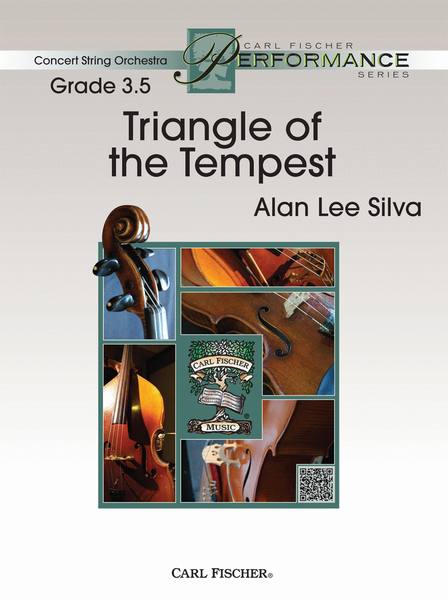Triangle of the Tempest
-
Ships in 24 hours
Details
Description
SKU: CF.CAS107
Composed by Alan Lee Silva. SWS FS. Carl Fischer Concert String Orchestra Series. Set of Score and Parts. With Standard notation. 24+24+6+15+15+15+6+20 pages. Duration 4 minutes, 17 seconds. Carl Fischer Music #CAS107. Published by Carl Fischer Music (CF.CAS107).ISBN 9781491146675. UPC: 680160904174. 9 x 12 inches. Key: E minor.
Triangle of the Tempest is a fast-moving composition with interesting rhythmic challenges and dynamic color shifts. Starting with syncopated figures over a repeated eight-measure progression, the piece builds in intensity as more sections and layers are added. The second part changes tone and is led by a heroic violin melody with a soaring cello obligato. The themes intertwine and the material develops into a dramatic conclusion with a final explosive ensemble hit. Action-packed and full of rhythmic drive, this piece is a good choice for contest or festival performance.
An up-tempo 3⁄4 piece in E minor, Triangle of the Tempest features inviting rhythmic challenges, provocative melodic variations and dynamic color shifts .The A-section is based on a repeating eight-measure harmonic progression with punctuated open voicings and syncopated figures . Each section builds in intensity as new elements are added in subsequent eight-measure increments . Rhythmically, the pattern in the A-section (mm . 1–36) follows a two-measure form: the first of the two measures has a dotted quarter-eighth syncopated figure, and the rhythms in the second measure fall primarily on the beats . After the main eight-measure pattern is established, the A-melody and its variations are introduced on top of it .A two-measure build (mm . 35–36), highlighted by fast moving ensemble triplet figures, propels the piece as it crescendos into the jubilant B-section (mm . 37–52), changing tone and moving to the relative G major . The violins carry the soaring melody atop sonorous major chords in the mid and low strings . Rhythmically, the alternating "syncopated measure/non-syncopated measure" form continues through this section .Returning to the dramatic E minor A-section phrases in mm . 53–86, the piece shifts to the original eight-measure harmonic progression with melodic variations in the violins over the top . After reprising the B-section (mm . 87–102), intertwining motifs at m . 103 offer a variation on the A-theme where the melodic entrances happen at one-measure intervals .The tempo slows slightly and the tone changes again in the flowing and magical C-section at m . 123 as the piece moves again to the relative G major . Repeating lyrical legato violin lines create the musical background for a majestic viola melody, featured in mm . 126–146 . A brief fanfare statement with motifs spread throughout the orchestra at m . 153, prepares the return to E minor and the A-theme in mm . 160–193 .Measure 194 introduces an E-pedal point and tension builds, ramping up emotionally to the ending . The ensemble thunders at m . 202 as the violins and violas begin a four-measure syncopated question/answer section with the cellos and basses . The phrases crescendo and build for another four measures at m . 206, setting up the driving unison, tutti figures at m . 211 and a final explosive hit on the downbeat of m . 212 .
About Carl Fischer Concert String Orchestra Series
This series of pieces (Grade 3 and higher) is designed for advancing ensembles. The pieces in this series are characterized by:
- Expanded use of rhythms, ranges and keys but technical demands are still carefully considered
- More comprehensive bowing techniques
- Viola T.C. included
- Careful selection of keys and degree of difficulty for advancing musicians

 Share
Share